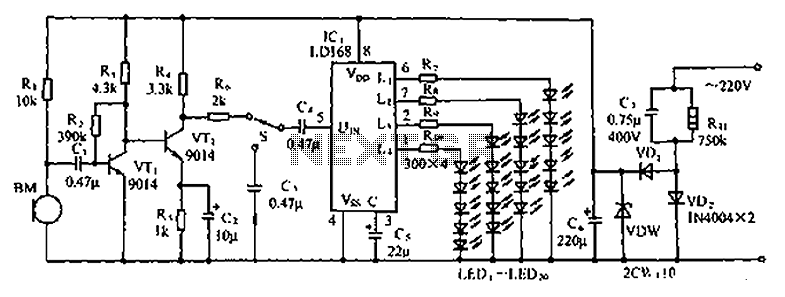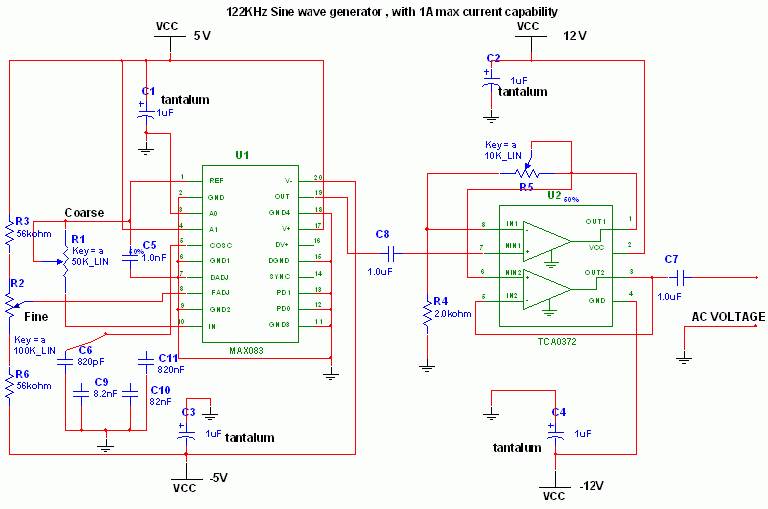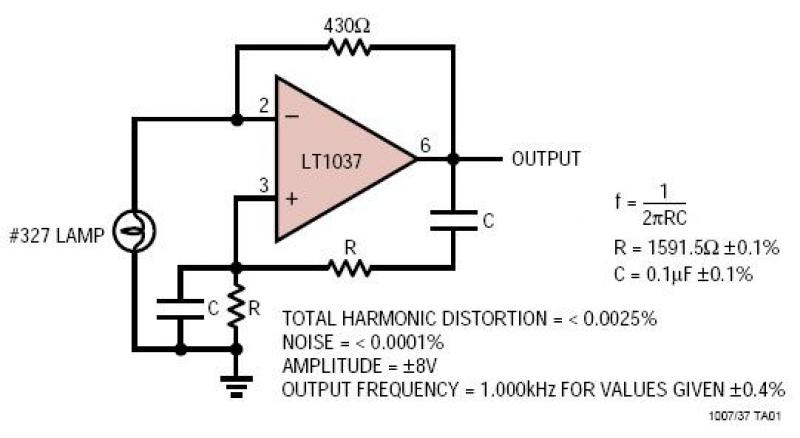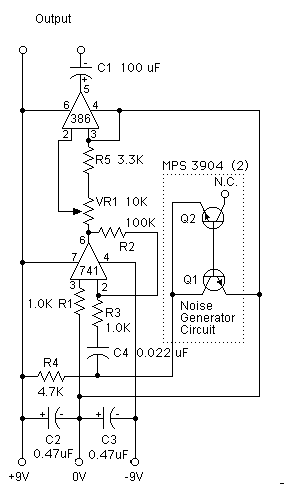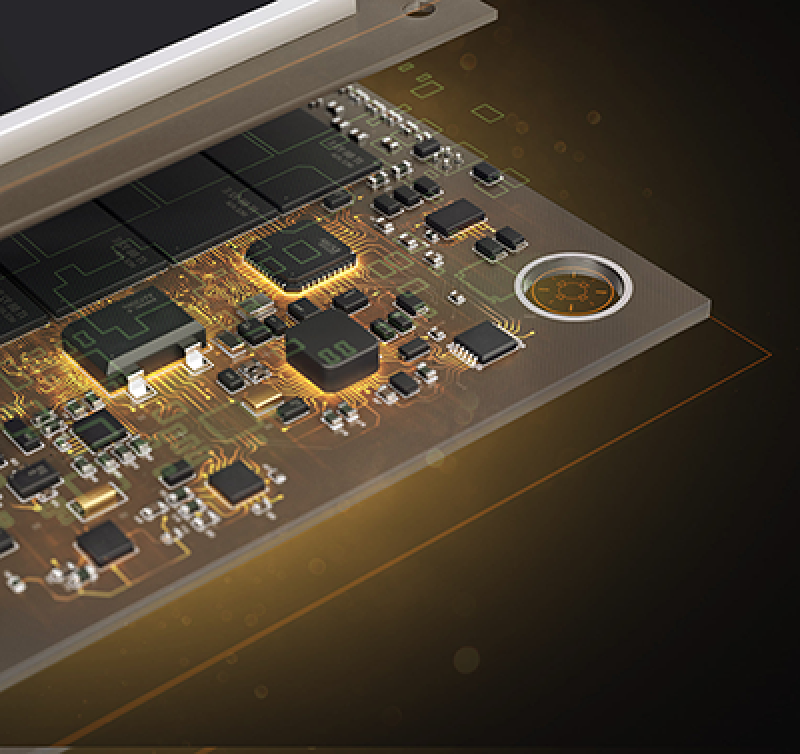
reference design digitally controlled sine wave generator

The circuit illustrated in Figure 1 generates a precise variable-frequency sine wave intended for use as a general-purpose reference signal. It incorporates an 8th-order elliptic switched-capacitor low-pass filter (IC3), which is clocked by a 100 kHz square wave produced by microcontroller IC2. An alternative square wave source may also be utilized. The microcontroller is driven by a 10 MHz oscillator module. A voltage supervisor (IC1) guarantees proper operation during power failures. The cutoff frequency of IC3 is set to one-hundredth of the clock frequency. The sharp roll-off of the 8th-order elliptic filter significantly diminishes the harmonic amplitudes present in a 1 kHz square wave input, resulting in a nearly ideal 1 kHz sine wave output. By employing divider-chain logic or a processor, a digitally adjustable sine wave source can be created by varying the clock and input frequencies while maintaining a 100:1 ratio between them. To avoid clipping at both the positive and negative peaks, the input signal should be attenuated and superimposed on a DC level of VCC/2. For a 5V input, this configuration yields a 2.25V peak-to-peak output.
The circuit's design emphasizes precision and flexibility in generating sine wave signals suitable for various applications. The 8th-order elliptic filter is a critical component, as its design allows for a steep roll-off characteristic that effectively suppresses unwanted harmonics, thus ensuring signal integrity. The use of a microcontroller to generate the clock signal provides programmability, enabling users to adjust the frequency output dynamically.
The voltage supervisor (IC1) plays an essential role in maintaining circuit stability, especially in environments where power fluctuations may occur. This component monitors the supply voltage and ensures that the circuit operates only when sufficient power is available, preventing potential damage or erroneous outputs.
The relationship between the clock frequency and the input frequency is crucial, as maintaining a 100:1 ratio allows for a broad range of sine wave frequencies to be generated. This flexibility is beneficial for applications requiring precise frequency control. Additionally, the provision for attenuation and DC level adjustment ensures that the output remains within safe limits, thereby preventing distortion or clipping of the waveform.
Overall, this circuit provides a robust solution for generating high-quality sine wave signals, making it an invaluable tool for testing and reference purposes in various electronic applications.The circuit of Figure 1 produces an accurate variable-frequency sine wave for use as a general-purpose reference signal. It includes an 8th-order elliptic, switched-capacitor lowpass filter (IC3) that is clocked with a 100kHz square wave generated by microcontroller IC2.
(Any other convenient squarewave source is also acceptable. ) The microcontrol ler is clocked by a 10MHz oscillator module. A voltage supervisor (IC1) ensures correct operation in the event of a power failure. IC3 sets the filter`s cutoff frequency at 1/100 the clock frequency. The 8th-order elliptic filter`s sharp rolloff sharply reduces the harmonic amplitudes in a 1kHz square-wave input, thereby producing a near-perfect 1kHz sine wave at its output. Using divider-chain logic or a processor, you can then create a digitally adjustable sine-wave source by adjusting the clock and input frequencies while maintaining a ratio of 100:1 between them.
To prevent clipping at the positive and negative peaks, attenuate the input signal and superimpose it on a dc level of VCC/2. The result (for a 5V input) is a 2. 25V peak-to-peak output. 🔗 External reference
The circuit's design emphasizes precision and flexibility in generating sine wave signals suitable for various applications. The 8th-order elliptic filter is a critical component, as its design allows for a steep roll-off characteristic that effectively suppresses unwanted harmonics, thus ensuring signal integrity. The use of a microcontroller to generate the clock signal provides programmability, enabling users to adjust the frequency output dynamically.
The voltage supervisor (IC1) plays an essential role in maintaining circuit stability, especially in environments where power fluctuations may occur. This component monitors the supply voltage and ensures that the circuit operates only when sufficient power is available, preventing potential damage or erroneous outputs.
The relationship between the clock frequency and the input frequency is crucial, as maintaining a 100:1 ratio allows for a broad range of sine wave frequencies to be generated. This flexibility is beneficial for applications requiring precise frequency control. Additionally, the provision for attenuation and DC level adjustment ensures that the output remains within safe limits, thereby preventing distortion or clipping of the waveform.
Overall, this circuit provides a robust solution for generating high-quality sine wave signals, making it an invaluable tool for testing and reference purposes in various electronic applications.The circuit of Figure 1 produces an accurate variable-frequency sine wave for use as a general-purpose reference signal. It includes an 8th-order elliptic, switched-capacitor lowpass filter (IC3) that is clocked with a 100kHz square wave generated by microcontroller IC2.
(Any other convenient squarewave source is also acceptable. ) The microcontrol ler is clocked by a 10MHz oscillator module. A voltage supervisor (IC1) ensures correct operation in the event of a power failure. IC3 sets the filter`s cutoff frequency at 1/100 the clock frequency. The 8th-order elliptic filter`s sharp rolloff sharply reduces the harmonic amplitudes in a 1kHz square-wave input, thereby producing a near-perfect 1kHz sine wave at its output. Using divider-chain logic or a processor, you can then create a digitally adjustable sine-wave source by adjusting the clock and input frequencies while maintaining a ratio of 100:1 between them.
To prevent clipping at the positive and negative peaks, attenuate the input signal and superimpose it on a dc level of VCC/2. The result (for a 5V input) is a 2. 25V peak-to-peak output. 🔗 External reference
